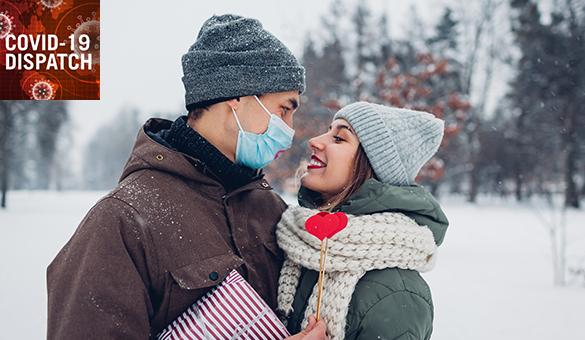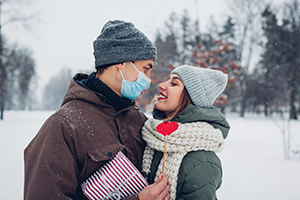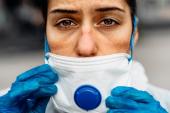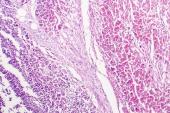COVID-19: TCTMD’s Dispatch for March Week 1
We’re curating a list of COVID-19 research and other useful content, and updating it regularly.

Since March 2020, TCTMD reporter Todd Neale has been writing up breaking news and peer-reviewed research related to COVID-19 every weekday. In July 2021, we transitioned to Mondays, Wednesdays, and Fridays. If you have something to share, tell us. All of our COVID-19 coverage can be found on our COVID-19 Hub.
March 4, 2022
 This week, US Surgeon General Vivek Murthy, MD, formally requested that major technology platforms submit information about COVID-19 misinformation on their social networks, search engines, crowdsourced platforms, e-commerce platforms, and instant messaging systems. According to the New York Times, the request is part of President Joe Biden’s National COVID-19 Preparedness Plan, which includes combatting misinformation and disinformation.
This week, US Surgeon General Vivek Murthy, MD, formally requested that major technology platforms submit information about COVID-19 misinformation on their social networks, search engines, crowdsourced platforms, e-commerce platforms, and instant messaging systems. According to the New York Times, the request is part of President Joe Biden’s National COVID-19 Preparedness Plan, which includes combatting misinformation and disinformation.
In-hospital cardiac arrest patients infected with SARS-CoV-2 have lower rates of survival to discharge and of a return of spontaneous circulation for 20 minutes or more compared with noninfected patients. As TCTMD’s Todd Neale reports, while survival in COVID-19 patients was poor (11.9%), it was better than some had feared based on initial small studies out of the US and China that put chances of survival at zero to 3%.
As of this week, every state in the US has identified at least one test sample showing infection with the Omicron subvariant BA.2, according to Becker’s Hospital Review. The highest prevalence is in the smallest state, Rhode Island, with over 200 positive samples so far. CDC estimates suggest that the prevalence of BA.2 in the US is doubling each week.
 Anti-Asian racism and violence associated with the COVID-19 pandemic has shown no signs of slowing down, even as the pandemic has lessened in intensity, according to the group Stop AAPI Hate. HuffPost says the group collected 10,905 self-reported incidents of racism and discrimination against Asian Americans that occurred between March 2020 and December 2021.
Anti-Asian racism and violence associated with the COVID-19 pandemic has shown no signs of slowing down, even as the pandemic has lessened in intensity, according to the group Stop AAPI Hate. HuffPost says the group collected 10,905 self-reported incidents of racism and discrimination against Asian Americans that occurred between March 2020 and December 2021.
A population-based study conducted between November 2021 and January 2022 confirms current thinking that two doses of vaccine (Pfizer/BioNTech, Oxford/AstraZeneca, or Moderna) provide limited protection against symptomatic COVID-19 illness caused by the Omicron variant. Writing in the New England Journal of Medicine, the British investigators say they found that while boosters appear to provide increased protection against mild disease, their efficacy wanes over time.
Evidence of vaccine effectiveness in adolescents is limited outside of clinical trials. A paper published in JAMA Network Open offers some reassuring evidence that within 4 months of completing a two-dose vaccination regimen, kids in the study between the ages of 12 and 18 showed 91% protection against any COVID-related infection and 85% protection against asymptomatic infection.
Also in JAMA Network Open, researchers review the experience of two COVID-19-specific hospitals in Minnesota focused on constant evaluation of practice guidelines and close monitoring of patient outcomes. Overall, they found a mortality benefit compared with treatment in standard hospitals, and suggest that in the event of future outbreaks of viral pneumonia or other infectious diseases, “the success of our model could provide a potential framework for large healthcare organizations looking to isolate patients with infections and provide the best care for these individuals.”
 Researchers writing in the Lancet have attempted to quantify the impact of COVID-19 on gender disparities, concluding that COVID-19 has only served to exacerbate preexisting “widespread inequalities” between women and men. “Political and social leaders should prioritize policies that enable and encourage women to participate in the labor force and continue their education, thereby equipping and enabling them with greater ability to overcome the barriers they face.”
Researchers writing in the Lancet have attempted to quantify the impact of COVID-19 on gender disparities, concluding that COVID-19 has only served to exacerbate preexisting “widespread inequalities” between women and men. “Political and social leaders should prioritize policies that enable and encourage women to participate in the labor force and continue their education, thereby equipping and enabling them with greater ability to overcome the barriers they face.”
March 1, 2022
 COVID-19 cases are still surging in Hong Kong, where the government has announced plans to impose compulsory mass testing, Reuters reports. “Authorities reported a new daily record of 55,353 new infections, with 117 deaths in the Chinese-ruled city. Infections have surged more than 500 times from about 100 cases a day at the beginning of February.”
COVID-19 cases are still surging in Hong Kong, where the government has announced plans to impose compulsory mass testing, Reuters reports. “Authorities reported a new daily record of 55,353 new infections, with 117 deaths in the Chinese-ruled city. Infections have surged more than 500 times from about 100 cases a day at the beginning of February.”
Two days ago, new data posted to the medRxiv server reported that the Pfizer/BioNTech vaccine is far less effective in children ages 5 to 11 than it is in older kids (and adults). One day later, new numbers have a different take: researchers from the Centers for Disease Control and Prevention (CDC), writing in Morbidity and Mortality Weekly Report, say that a two-dose regimen doesn’t protect well against infection in this younger group, but it doesn’t do so in older kids and adolescents either. On the other hand, protection against severe infection was strong in both groups. A STAT news article explores the new findings, noting: “They do not suggest more rapid waning, or more marked waning, among the younger group of children.”
All 535 members of the US Congress were invited to attend President Joe Biden’s State of the Union address last night: at least six legislators did not attend after testing positive for coronavirus, NPR reports. Testing was a requirement for all guests.
In his speech, Biden said that the US will “never just accept living with COVID-19” but proposed “four common sense steps as we move forward safely.” STAT has a summary of Biden’s cautiously optimistic plan to help Americans reach the other side of the pandemic, noting that over 950,000 Americans have died from COVID-19, “and with death rates still close to 2,000 each day, the country is likely to hit the grim milestone of 1 million total COVID-19 deaths within weeks.”
Full details of the Biden administration’s 96-page plan, released today, can be found here.
 The CDC announced this week that universal case investigation and contact tracing are no longer recommended for COVID-19. That follows a similar move by Britain last week, and “reflects the reality that contact-tracing programs in about half of US states have been eliminated,” the New York Times points out.
The CDC announced this week that universal case investigation and contact tracing are no longer recommended for COVID-19. That follows a similar move by Britain last week, and “reflects the reality that contact-tracing programs in about half of US states have been eliminated,” the New York Times points out.
One of the largest comparative-effectiveness studies to date, pitting Janssen’s single-dose Ad26.COV2.S vaccine against Pfizer/BioNTech’s double-dose BNT162b2 vaccine, indicates that the latter is five times more effective at preventing COVID-19 hospitalizations when “full” vaccinations were compared. “On the basis of these results and an effectiveness of BNT162b2 of 92% (95% CI, 90%-94%) estimated from the same data set, we obtained an absolute effectiveness of Ad26.COV2.S of 59% (95% CI, 33%-75%),” authors write in JAMA Network Open. “These results strengthen the evidence supporting a second dose in people who received the Ad26.COV2.S vaccine by an mRNA vaccine as recommended in both France and the US.”
Also in JAMA Network Open: patients with COVID-19 fare worse after an in-hospital cardiac arrest, but the situation isn’t as dire as suggested by reports that emerged earlier in the pandemic, US data indicate. Compared with hospitalized patients who were not infected with SARS-CoV-2, those with COVID-19 had lower rates of survival to discharge and were less likely to see a return of spontaneous circulation for 20 minutes or more. TCTMD’s Todd Neale has full details, coming soon.
JAMA Medical News & Perspectives summarizes a Nature Medicine paper addressing the long-term cardiovascular effects of COVID-19 earlier covered by TCTMD’s Caitlin Cox. “The increased risks were most pronounced for heart failure and atrial fibrillation, but the breadth of cardiovascular disease involvement was ‘eye opening,’” a study author told JAMA writer Jennifer Abbasi.
The number of cases of an Omicron “subvariant” is doubling every week in the United States, according to CDC stats. Becker’s Hospital Review offers “five things to know” about the variant and its spread. Last week, as reported by Reuters, the Africa Centres for Disease Control and Prevention, based on data out of South Africa, concluded that the substrain is more infectious than the original Omicron, but not associated with more-severe illness.
A British study of remote home monitoring using pulse oximetry in people who test positive for COVID-19 as a means of detecting “silent hypoxia” and ideally preempting progression to severe disease and death has delivered inconclusive results, researchers report in the Lancet eClinicalMedicine. They found that for every 10% increase in the coverage of the at-home testing program, mortality dropped by 2%, hospital admissions increased by 3%, in-hospital mortality fell by 3%, and lengths of stay increased by 1.8%, but none of these changes were statistically significant. “Although we detected no significant impact on outcomes, there are potential explanations for this finding that are unrelated to the effectiveness of the program,” researchers conclude. “Taking due account of populations that may respond less well to oximetry, there is no evidence that future implementation of similar programs would be unsafe. However, the challenges of providing sufficient data so that effectiveness can be adequately measured need to be overcome.”
Yesterday, the FDA issued a volley of warnings about at-home COVID-19 test kits, including certain ACON Flowflex, Biosensor STANDARD Q COVID-19 Ag, and Celltrion DiaTrust tests, warning that these can deliver false results. An editorial in Nature Medicine explains why an “outdated” regulatory waiver for “laboratory-developed tests” stemming from the same lab is letting faulty tests onto the US market, arguing: “It is time to close a loophole that allows certain types of diagnostic lab tests to be exempt from regulatory oversight, putting people at risk of making consequential medical decisions on the basis of unreliable results.”
 An article in the Guardian looks at the ongoing research into why some people never catch COVID-19. “Phoebe Garrett has attended university lectures without catching COVID; she even hosted a party where everyone subsequently tested positive except her,” writes Linda Geddes. “In March 2021, she participated in the world’s first COVID-19 challenge trial, which involved dripping live virus into her nose and pegging her nostrils shut for several hours, in a deliberate effort to infect her. Still her body resisted.”
An article in the Guardian looks at the ongoing research into why some people never catch COVID-19. “Phoebe Garrett has attended university lectures without catching COVID; she even hosted a party where everyone subsequently tested positive except her,” writes Linda Geddes. “In March 2021, she participated in the world’s first COVID-19 challenge trial, which involved dripping live virus into her nose and pegging her nostrils shut for several hours, in a deliberate effort to infect her. Still her body resisted.”
February 28, 2022
 As predicted, the US Centers for Disease Control and Prevention (CDC) released its new guidance for mask-wearing last Friday, making it optional in parts of the country where hospitals are not overburdened by COVID-19 admissions. “Under the new guidance, nearly 70% of the US population lives in an area considered to be low or medium risk, and residents there are advised they can go indoors without masks,” NPR summarizes.
As predicted, the US Centers for Disease Control and Prevention (CDC) released its new guidance for mask-wearing last Friday, making it optional in parts of the country where hospitals are not overburdened by COVID-19 admissions. “Under the new guidance, nearly 70% of the US population lives in an area considered to be low or medium risk, and residents there are advised they can go indoors without masks,” NPR summarizes.
The state of New York subsequently announced that it will drop vaccine passports for restaurants, gyms, and movie theaters, as well as masks in schools, while the US House of Representatives has lifted the mask mandate in the Capitol in time for the State of the Union address.
Mask mandates and pandemic restrictions are continuing to be eased in other parts of the globe. Wales and Scotland are cautiously following the example set by England last week and moving to lift some mask requirements and vaccination proof in certain settings, although neither has gone as far as their English neighbor. South Korea is dropping proof of vaccine requirements, while travelers to New Zealand no longer need to self-isolate. The premier of Canada’s most populace province, Ontario, says the province “isn’t far away” from lifting its mask mandate.
But not every region of the globe is in a position to ease off: Hong Kong mortuaries have “hit capacity” as deaths climb there, as a Reuters story details.
We have just released two preprints on the origin of SARS-CoV-2:
— Michael Worobey (@MichaelWorobey) February 26, 2022
1. "The Huanan market was the epicenter of SARS-CoV-2 emergence"https://t.co/OAVNoWdezs
Three new preprint studies pinpoint the Huanan Seafood Wholesale Market in Wuhan, China, as the source of the COVID-19 pandemic, with animal-to-human transmission providing the link. “Two of the reports trace the outbreak back to a massive market that sold live animals, among other goods, in Wuhan, China, and a third suggests that SARS-CoV-2 spilled over from animals—possibly those sold at the market—into humans at least twice in November or December 2019. A Nature news story summarizes the three papers. “When you look at all of the evidence together, it’s an extraordinarily clear picture that the pandemic started at the Huanan market,” evolutionary biologist and co-author Michael Worobey, PhD, told the New York Times.
A new study based on data collected in New York state and posted to the medRxiv server suggests that the Pfizer/BioNTech vaccine is far less effective in children ages 5 to 11 than it is in older kids and adults. Though not yet peer-reviewed, the study showed that full vaccination in this group had little to no effect at preventing infection, as compared with efficacy in adolescents and teens ages 12 to 18. It did, however, appear to protect against severe disease. As a New York Times article explores, the possibility exists that the lower dose given to this age group may be to blame for its reduced effects.
 A strategy of giving just one dose of an mRNA-based COVID-19 vaccine to adolescents appears to limit associated rare cases of myocarditis, according to a study out of Hong Kong published last week in JAMA Pediatrics. Of 43 vaccine-related myocarditis cases identified, none occurred after a single-dose policy was implemented. The Hong Kong researchers propose that “in countries with large outbreaks and to [prevent] local transmission, the risk-benefit assessment would favor a two-dose regimen because the single-dose regimen provides suboptimal protection from severe outcomes associated with COVID-19.” In settings with no local transmissions and stringent infection control, however, “single-dose mRNA vaccination might be a viable option for offering protection to adolescents from severe outcomes associated with COVID-19.” TCTMD’s Todd Neale explores the implications.
A strategy of giving just one dose of an mRNA-based COVID-19 vaccine to adolescents appears to limit associated rare cases of myocarditis, according to a study out of Hong Kong published last week in JAMA Pediatrics. Of 43 vaccine-related myocarditis cases identified, none occurred after a single-dose policy was implemented. The Hong Kong researchers propose that “in countries with large outbreaks and to [prevent] local transmission, the risk-benefit assessment would favor a two-dose regimen because the single-dose regimen provides suboptimal protection from severe outcomes associated with COVID-19.” In settings with no local transmissions and stringent infection control, however, “single-dose mRNA vaccination might be a viable option for offering protection to adolescents from severe outcomes associated with COVID-19.” TCTMD’s Todd Neale explores the implications.
A Bayesian reanalysis of an earlier meta-analysis of 15 studies assessing the benefits of tocilizumab and corticosteroids in hospitalized patients has found that the “probability of a clinically meaningful mortality benefit from tocilizumab” was seen only in patients being treated with simple oxygen or noninvasive ventilation. In those requiring invasive mechanical ventilation (IMV), the benefit of the drug was unclear, with analyses unable to exclude the possibility of harm. “Future research should clarify whether patients receiving IMV also benefit from tocilizumab,” authors write in JAMA Network Open today.
A CDC analysis of household Omicron transmissions published in Morbidity and Mortality Weekly Report confirms what many households have already discovered: one in two contacts cohabitating developed COVID-19 from an infected household member. “Omicron infection resulted in high transmission among household contacts, particularly among those who lived with index patients who were not vaccinated or who did not take measures to reduce the risk of transmission to household contacts,” the authors concluded. Spread was lowest if the household member limited contacts, was fully vaccinated, and wore a mask in the home.
Arbutus Biopharma Corp is suing Moderna for patent infringement. “Arbutus said it developed the so-called lipid nanoparticles (LNP) that enclose genetic materials known as messenger RNA or mRNA, the patents related to which were licensed to Genevant Sciences, a joint venture between Arbutus and Roivant Sciences Ltd,” Reuters reports.
 Canadian researchers say they have identified what they believe to be the first case of a deer-to-human transmission of COVID-19. Scientists have already raised concerns that white-tailed deer might become a reservoir for virus transmission and mutation. Now, a paper published to the bioRxiv preprint server last week describes “a new and highly divergent lineage of SARS-CoV-2” in a deer population, with an epidemiologically linked case in the same geographic region. A report in the Guardian explains the worrisome implications, noting “the virus bears little resemblance to strains currently circulating in human populations.”
Canadian researchers say they have identified what they believe to be the first case of a deer-to-human transmission of COVID-19. Scientists have already raised concerns that white-tailed deer might become a reservoir for virus transmission and mutation. Now, a paper published to the bioRxiv preprint server last week describes “a new and highly divergent lineage of SARS-CoV-2” in a deer population, with an epidemiologically linked case in the same geographic region. A report in the Guardian explains the worrisome implications, noting “the virus bears little resemblance to strains currently circulating in human populations.”
Todd Neale is the Associate News Editor for TCTMD and a Senior Medical Journalist. He got his start in journalism at …
Read Full Bio





Comments